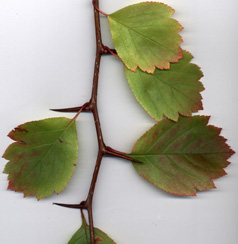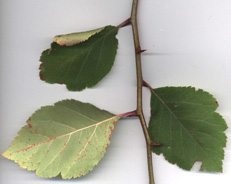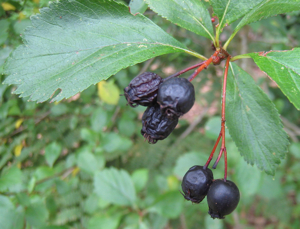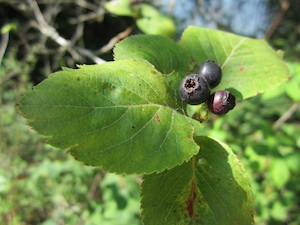Plant of the Month: February 2006
|
| Black Hawthorn |
Cratægus Douglasii Lindl.
|
and
|
Cratægus Suksdorfii (Sarg.) Kruschke
|
(ROSACEÆ); Rose Family
|
| The genus Cratægus consists of more than 200 species of hardy small trees or shrubs. Eastern North America has most of the species (160+). All produce berries called haws, and nearly all are thorny. Leaves are generally small and jaggedly lobed. The flowers are small, white (pink in a few cultivars), primarily in May and June. Haws are usually red and less than an inch long. Rugged, twisting, branches form dense heads, usually spreading rather than upright. Hawthorns are pioneer trees and loathe shade. The name Cratægus came from Greek krataigos, a flowering thorn --in turn from kratos, strength, referring to the strong and hard wood. Hawthorn derives from Old English haga, a hedge, and thorn: hedgethorn. |
| As ornamental trees hawthorns offer seasonal beauty and often attract birds. Their foliage is frequently more interesting and healthier than that of most cherries (Prunus) or crab apples (Malus), two related genera. Hawthorns are long suffering and endure pruning well, so can be used for hedging. Many of the species are able to reproduce from seed as genetically identical individuals, a process called apomixis. Botanists used to describe nearly every variant as a separate species; despair ensued as well over 1,000 species were described (the heyday was from 1896 to 1910, when 886 new species were described). Now the trend is to recognize comparatively few species, but grant them great variability. Nonetheless, the decision as to what constitutes a species and what a mere variety is vexing, and, frankly, arbitrary. Cratægus Suksdorfii was first named in 1907 as a mere variant of C. Douglasii. |
David Douglas (1789 - 1834) was a renowned Scot plant explorer who had many species named after him, including Douglas Fir. Wilhelm N. Suksdorf (1850 - 1932) was a major Washington State botanist.
|
| In the second edition of Trees of Seattle I changed my long-held stance on Black Hawthorn. This article elaborates. Heretofore, in the 1989 Trees of Seattle, the 1996 North American Landscape Trees, and the 2001 Wild Plants of Greater Seattle, I differed. In those books I recognized Black Hawthorn as one widespread and variable species. On several occasions I had tried in vain to reconcile the reported distinctions that justified recognizing two different albeit similar species. At the bottom of this page I include a chart of differences. |
| In addition, C. Douglasii does not hybridize with the introduced European C. monogyna, as far as reported. But C. Suksdorfii does. |
| In the last several years I examined closely every wild or planted specimen of Black Hawthorn that I saw in or near Seattle. In doing so, I found that with one exception of a mercilessly overpruned tree, in every case I could state that a given individual was one species or the other. |
| Both grow wild in Seattle as natives, but nearly all the planted Black Hawthorns are C. Douglasii rather than C. Suksdorfii. The easiest way to tell the two apart, even in winter, is thorn length. Therefore I am proposing the C. Douglasii still be called Black Hawthorn, but C. Suksdorfii be called Shortspine Black Hawthorn. In general, the Black Hawthorn usually has spines an inch or so long; Shortspine Black Hawthorn has spines only about a third of an inch, or maybe a half inch. |
| I have yet to determine various other matters, such as whether the haws of one species are better eating than of the other. The haws are black, ripening early (sometimes in early July), up to half an inch long; the flesh varies from mealy and dryish to moist, soft, greenish, and pleasingly flavored; the haws eventually shrivel and hang like black raisins. Although the flowers are ornamental, the dark fruit and unspectacular fall color limit the ornamental appeal of these species. |
| Because of recent enthusiasm for planting native species, many young Black Hawthorn trees exist in Seattle. But Shortspine Black Hawthorns are almost never seen planted. There likely are some youngsters at Magnuson Park --but I prefer to wait for them to grow larger before I am sure about their identity. |
Regarding ultimate size, I wrote in the chart above that C. Douglasii grows larger than C. Suksdorfii. That may be true, but the specific identity of former "national champion" specimens is not usually known now. A tree 51 feet tall at Lake Quinault, with its trunk 7 and a half feet in circumference (1988), fell; but all the specimens near it are C. Suksdorfii. Beacon Rock State Park had a tree that in 1993 measured 41 feet tall, 57 feet wide, the largest of its three trunks 9 and a half feet in circumference. But it is gone now, and that locale has both species growing together.
Back |

C. Douglasii scan by ALJ |

C. Suksdorfii scan by ALJ |

C. Douglasii berries photo by ALJ |

C. Suksdorfii berries photo by ALJ |
|
|

